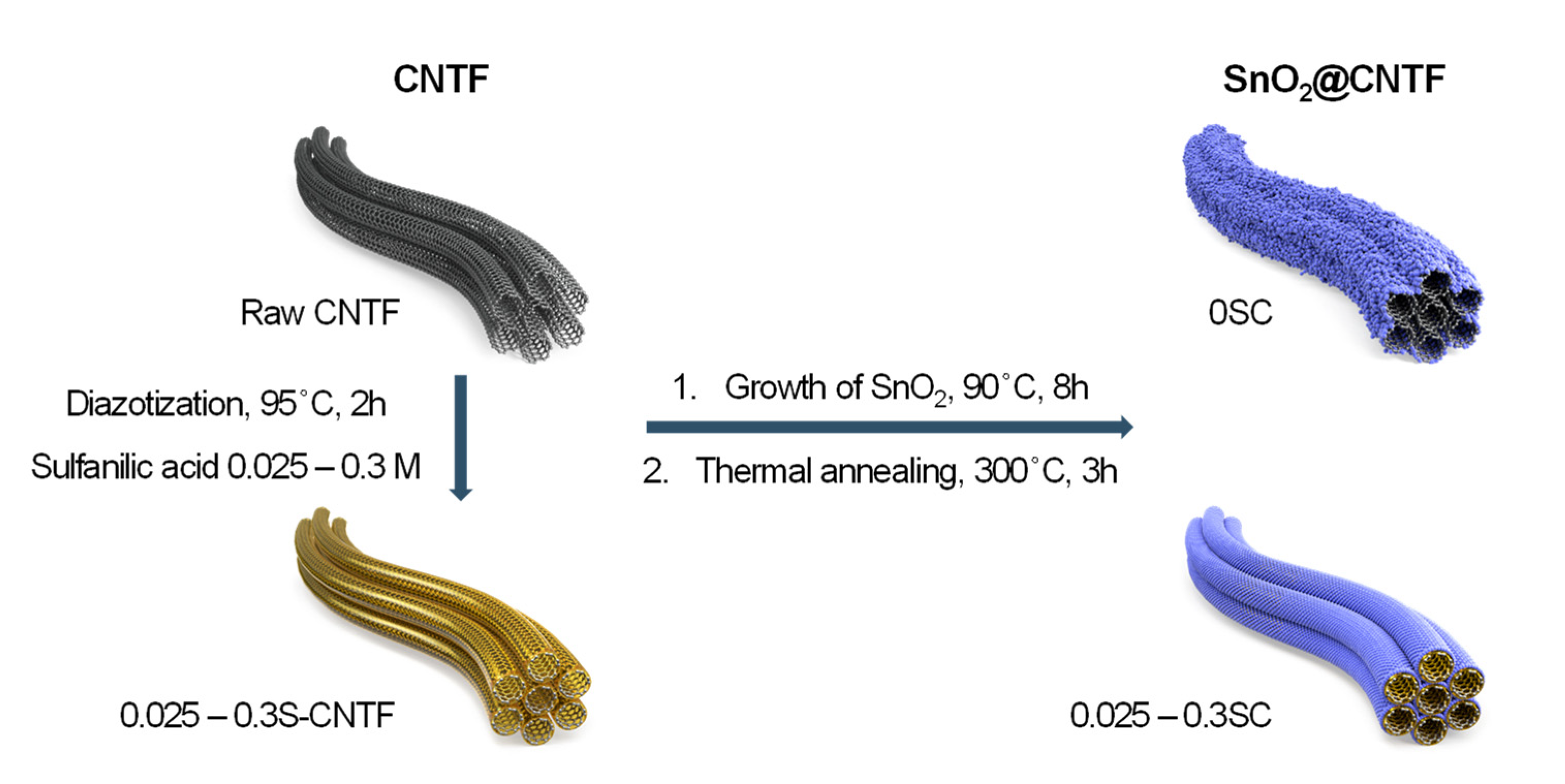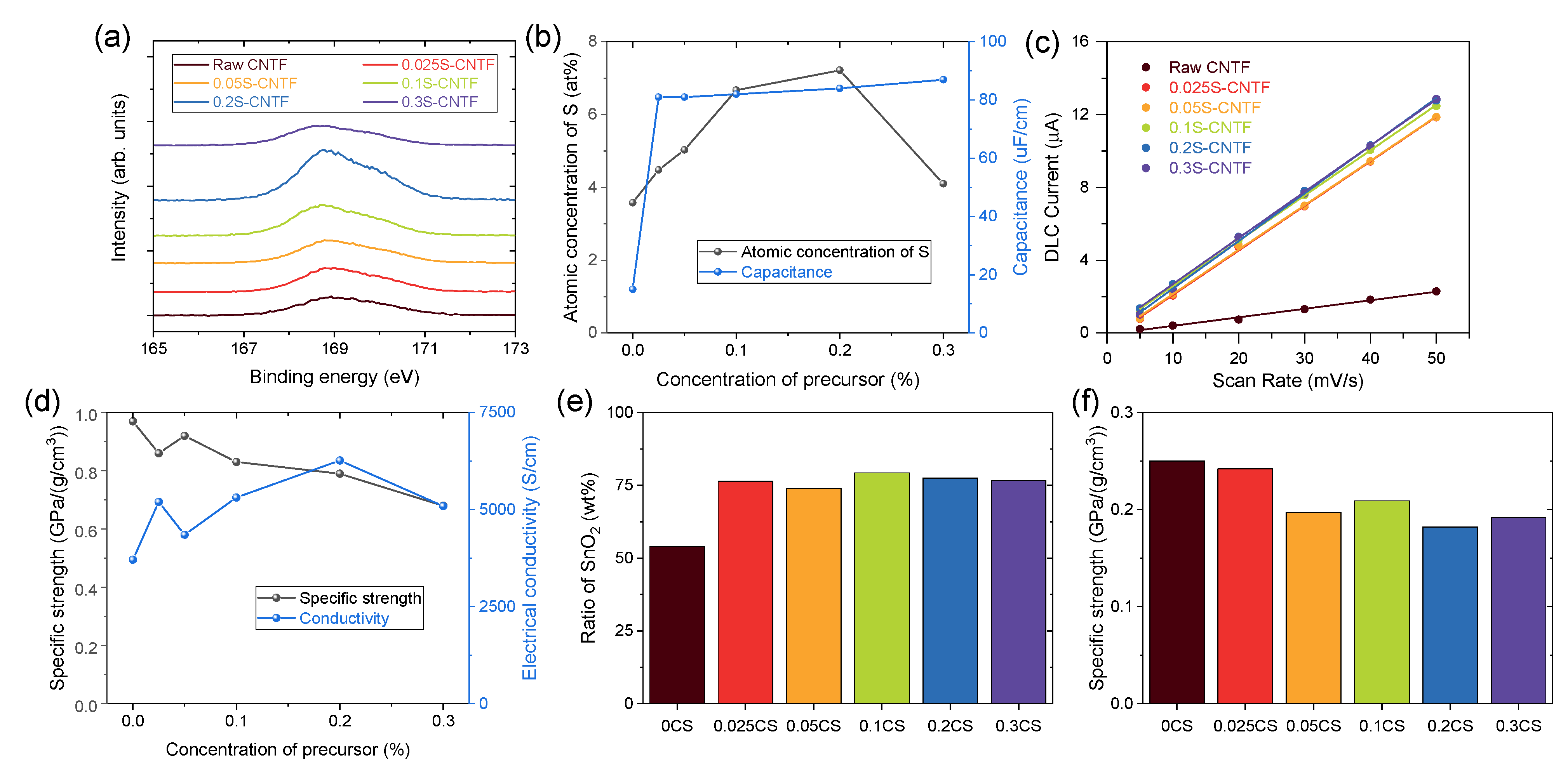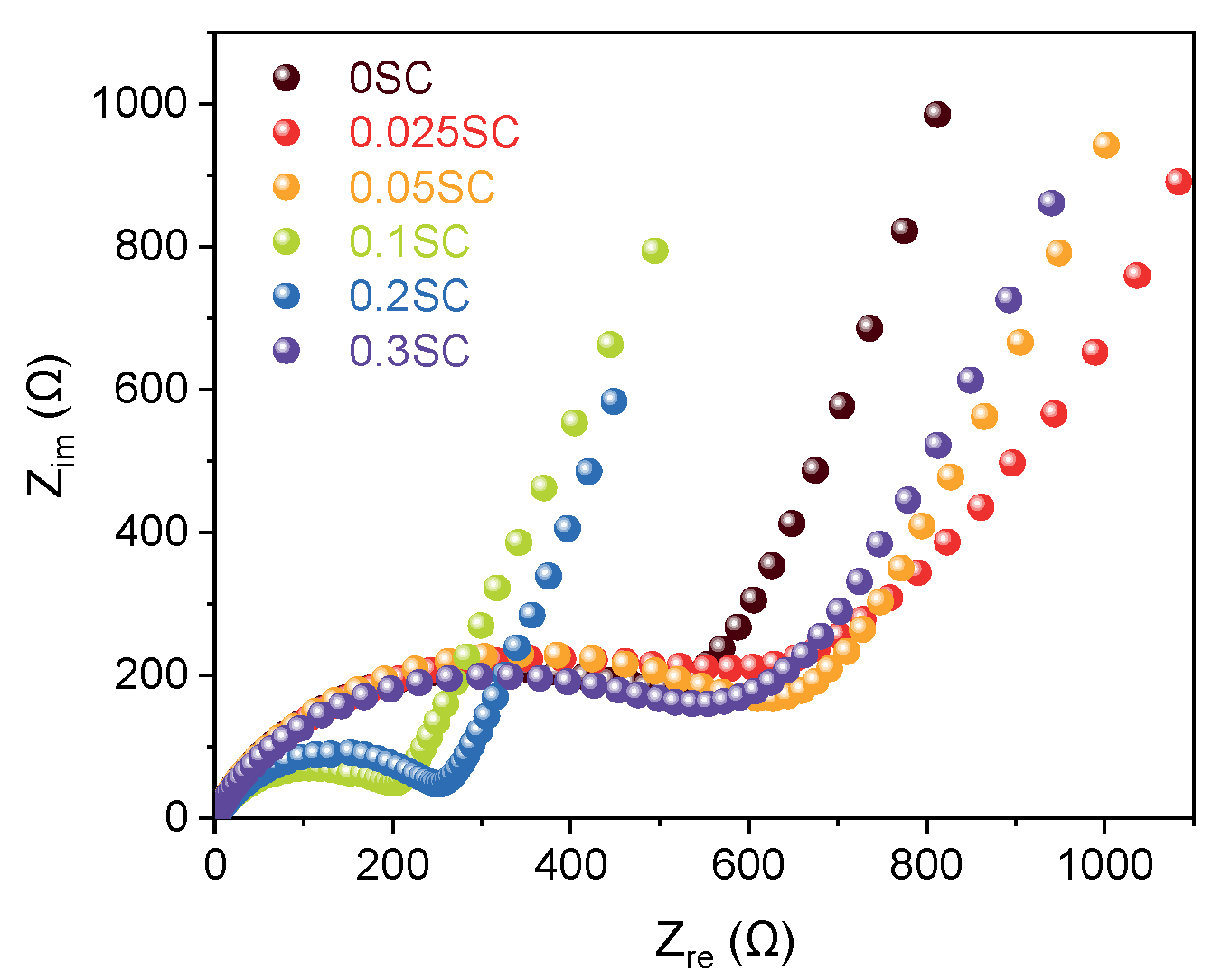Hydrophilic and Conductive Carbon Nanotube Fibers for High-Performance Lithium-Ion Batteries
Abstract
:1. Introduction
2. Materials and Methods
2.1. Preparation of SnO2 Nanoparticles@CNTF
2.2. Characterization
2.3. Cell Testing
3. Results
4. Conclusions
Author Contributions
Funding
Institutional Review Board Statement
Informed Consent Statement
Data Availability Statement
Conflicts of Interest
References
- Kim, S.W.; Kim, T.; Kim, Y.S.; Choi, H.S.; Lim, H.J.; Yang, S.J.; Park, C.R. Surface modifications for the effective dispersion of carbon nanotubes in solvents and polymers. Carbon 2012, 50, 3–33. [Google Scholar] [CrossRef]
- Mohammed, M.K.A.; Shekargoftar, M. Surface treatment of zno films with carbon nanotubes for efficient and stable perovskite solar cells. Sustain. Energy Fuels 2021, 5, 540–548. [Google Scholar] [CrossRef]
- Yuan, W.; Zhang, Y.; Cheng, L.; Wu, H.; Zheng, L.; Zhao, D. The applications of carbon nanotubes and graphene in advanced rechargeable lithium batteries. J. Mater. Chem. A 2016, 4, 8932–8951. [Google Scholar] [CrossRef]
- Cho, H.I.; Jeong, Y.C.; Kim, J.H.; Cho, Y.S.; Kim, T.; Yang, S.J.; Park, C.R. Rational design of 1d partially graphitized n-doped hierarchical porous carbon with uniaxially packed carbon nanotubes for high-performance lithium-ion batteries. ACS Nano 2018, 12, 11106–11119. [Google Scholar] [CrossRef]
- Yehezkel, S.; Auinat, M.; Sezin, N.; Starosvetsky, D.; Ein-Eli, Y. Bundled and densified carbon nanotubes (cnt) fabrics as flexible ultra-light weight li-ion battery anode current collectors. J. Power Sources 2016, 312, 109–115. [Google Scholar] [CrossRef]
- Yehezkel, S.; Auinat, M.; Sezin, N.; Starosvetsky, D.; Ein-Eli, Y. Distinct copper electrodeposited carbon nanotubes (cnt) tissues as anode current collectors in li-ion battery. Electrochim. Acta 2017, 229, 404–414. [Google Scholar] [CrossRef]
- Smail, F.; Boies, A.; Windle, A. Direct spinning of cnt fibres: Past, present and future scale up. Carbon 2019, 152, 218–232. [Google Scholar] [CrossRef]
- Weller, L.; Smail, F.R.; Elliott, J.A.; Windle, A.H.; Boies, A.M.; Hochgreb, S. Mapping the parameter space for direct-spun carbon nanotube aerogels. Carbon 2019, 146, 789–812. [Google Scholar] [CrossRef]
- Senokos, E.; Rana, M.; Santos, C.; Marcilla, R.; Vilatela, J.J. Controlled electrochemical functionalization of cnt fibers: Structure-chemistry relations and application in current collector-free all-solid supercapacitors. Carbon 2019, 142, 599–609. [Google Scholar] [CrossRef]
- Santos, C.; Lado, J.J.; García-Quismondo, E.; Rodríguez, I.V.; Hospital-Benito, D.; Palma, J.; Anderson, M.A.; Vilatela, J.J. Interconnected metal oxide cnt fibre hybrid networks for current collector-free asymmetric capacitive deionization. J. Mater. Chem. A 2018, 6, 10898–10908. [Google Scholar] [CrossRef] [Green Version]
- Rana, M.; Boaretto, N.; Mikhalchan, A.; Vila Santos, M.; Marcilla, R.; Vilatela, J.J. Composite fabrics of conformal mos2 grown on cnt fibers: Tough battery anodes without metals or binders. ACS Appl. Energy Mater. 2021, 4, 5668–5676. [Google Scholar] [CrossRef]
- Sung, S.J.; Kim, T.; Yang, S.J.; Oh, J.Y.; Park, C.R. New insights into the oxidation of single-walled carbon nanotubes for the fabrication of transparent conductive films. Carbon 2015, 81, 525–534. [Google Scholar] [CrossRef]
- Cheon, J.Y.; Ku, N.; Jung, Y.; Lee, K.; Kim, T. Hydrophilic treatment for strong carbon nanotube fibers. Funct. Compos. Struct. 2021, 3, 025002. [Google Scholar] [CrossRef]
- Azam, M.A.; Safie, N.E.; Ahmad, A.S.; Yuza, N.A.; Zulkifli, N.S.A. Recent advances of silicon, carbon composites and tin oxide as new anode materials for lithium-ion battery: A comprehensive review. J. Energy Storage 2021, 33, 102096. [Google Scholar] [CrossRef]
- Zoller, F.; Häringer, S.; Böhm, D.; Illner, H.; Döblinger, M.; Sofer, Z.k.; Finsterbusch, M.; Bein, T.; Fattakhova-Rohlfing, D. Overcoming the challenges of freestanding tin oxide-based composite anodes to achieve high capacity and increased cycling stability. Adv. Funct. Mater. 2021, 31, 2106373. [Google Scholar] [CrossRef]
- Kim, T.; Lee, J.; Lee, K.; Park, B.; Jung, B.M.; Lee, S.B. Magnetic and dispersible feconi-graphene film produced without heat treatment for electromagnetic wave absorption. Chem. Eng. J. 2019, 361, 1182–1189. [Google Scholar] [CrossRef]
- Lee, K.; Kim, T.; Lee, S.B.; Jung, B.M. Effect of pretreatment on magnetic nanoparticle growth on graphene surface and magnetic performance in electroless plating. J. Nanomater. 2019, 2019, 5602742. [Google Scholar] [CrossRef]
- Lee, K.; Lee, J.; Jung, B.M.; Park, B.; Kim, T.; Lee, S.B. Preparation of magnetic metal and graphene hybrids with tunable morphological, structural and magnetic properties. Appl. Surf. Sci. 2019, 478, 733–736. [Google Scholar] [CrossRef]
- Jung, Y.; Kim, T.; Park, C.R. Effect of polymer infiltration on structure and properties of carbon nanotube yarns. Carbon 2015, 88, 60–69. [Google Scholar] [CrossRef]
- Kim, T.; Shin, J.; Lee, K.; Jung, Y.; Lee, S.B.; Yang, S.J. A universal surface modification method of carbon nanotube fibers with enhanced tensile strength. Compos. Part A 2021, 140, 106182. [Google Scholar] [CrossRef]
- Shin, J.; Lee, K.; Jung, Y.; Park, B.; Yang, S.J.; Kim, T.; Lee, S.B. Mechanical properties and epoxy resin infiltration behavior of carbon-nanotube-fiber-based single-fiber composites. Materials 2021, 14, 106. [Google Scholar] [CrossRef] [PubMed]
- Lee, J.; Lee, D.-M.; Jung, Y.; Park, J.; Lee, H.S.; Kim, Y.-K.; Park, C.R.; Jeong, H.S.; Kim, S.M. Direct spinning and densification method for high-performance carbon nanotube fibers. Nat. Commun. 2019, 10, 2962. [Google Scholar] [CrossRef] [PubMed] [Green Version]
- Kim, T.; Han, G.; Jung, Y. Facile fabrication of polyvinyl alcohol/edge-selectively oxidized graphene composite fibers. Materials 2019, 12, 3525. [Google Scholar] [CrossRef] [PubMed] [Green Version]
- Reguero, V.; Alemán, B.; Mas, B.; Vilatela, J.J. Controlling carbon nanotube type in macroscopic fibers synthesized by the direct spinning process. Chem. Mater. 2014, 26, 3550–3557. [Google Scholar] [CrossRef]
- Yoon, Y.; Yan, B.; Surendranath, Y. Suppressing ion transfer enables versatile measurements of electrochemical surface area for intrinsic activity comparisons. J. Am. Chem. Soc. 2018, 140, 2397–2400. [Google Scholar] [CrossRef]
- Nikolou, M.; Malliaras, G.G. Applications of poly(3,4-ethylenedioxythiophene) doped with poly(styrene sulfonic acid) transistors in chemical and biological sensors. Chem. Rec. 2008, 8, 13–22. [Google Scholar] [CrossRef]
- Dini, Y.; Rouchon, D.; Faure-Vincent, J.; Dijon, J. Large improvement of cnt yarn electrical conductivity by varying chemical doping and annealing treatment. Carbon 2020, 156, 38–48. [Google Scholar] [CrossRef]
- Greenwood, M.; Wentker, M.; Leker, J. A bottom-up performance and cost assessment of lithium-ion battery pouch cells utilizing nickel-rich cathode active materials and silicon-graphite composite anodes. J. Power Sources Adv. 2021, 9, 100055. [Google Scholar] [CrossRef]
- Ji, H.; Ma, C.; Ding, J.; Yang, J.; Yang, G.; Chao, Y.; Yang, Y. Complementary stabilization by core/sheath carbon nanofibers/spongy carbon on submicron tin oxide particles as anode for lithium-ion batteries. J. Power Sources 2019, 413, 42–49. [Google Scholar] [CrossRef] [Green Version]
- Oh, S.-I.; Kim, J.-C.; Kim, D.-W. Cellulose-derived tin-oxide-nanoparticle-embedded carbon fibers as binder-free flexible li-ion battery anodes. Cellulose 2019, 26, 2557–2571. [Google Scholar] [CrossRef]
- Deng, D.; Lee, J.Y. Hollow core–shell mesospheres of crystalline SnO2 nanoparticle aggregates for high capacity Li+ ion storage. Chem. Mater. 2008, 20, 1841–1846. [Google Scholar] [CrossRef]
- Huang Jian, Y.; Zhong, L.; Wang Chong, M.; Sullivan John, P.; Xu, W.; Zhang Li, Q.; Mao Scott, X.; Hudak Nicholas, S.; Liu Xiao, H.; Subramanian, A.; et al. In situ observation of the electrochemical lithiation of a single sno2 nanowire electrode. Science 2010, 330, 1515–1520. [Google Scholar] [CrossRef] [Green Version]
- Liu, X.H.; Zhong, L.; Huang, S.; Mao, S.X.; Zhu, T.; Huang, J.Y. Size-dependent fracture of silicon nanoparticles during lithiation. ACS Nano 2012, 6, 1522–1531. [Google Scholar] [CrossRef]
- Ma, Z.; Li, T.; Huang, Y.L.; Liu, J.; Zhou, Y.; Xue, D. Critical silicon-anode size for averting lithiation-induced mechanical failure of lithium-ion batteries. RSC Adv. 2013, 3, 7398–7402. [Google Scholar] [CrossRef]
- Heiskanen, S.K.; Kim, J.; Lucht, B.L. Generation and evolution of the solid electrolyte interphase of lithium-ion batteries. Joule 2019, 3, 2322–2333. [Google Scholar] [CrossRef]
- Lou, X.W.; Chen, J.S.; Chen, P.; Archer, L.A. One-pot synthesis of carbon-coated SnO2 nanocolloids with improved reversible lithium storage properties. Chem. Mater. 2009, 21, 2868–2874. [Google Scholar] [CrossRef]
- Hu, J.; Wang, Q.; Fu, L.; Rajagopalan, R.; Cui, Y.; Chen, H.; Yuan, H.; Tang, Y.; Wang, H. Titanium monoxide-stabilized silicon nanoparticles with a litchi-like structure as an advanced anode for li-ion batteries. ACS Appl. Mater. Interfaces 2020, 12, 48467–48475. [Google Scholar] [CrossRef]
- Song, D.; Wang, S.; Liu, R.; Jiang, J.; Jiang, Y.; Huang, S.; Li, W.; Chen, Z.; Zhao, B. Ultra-small SnO2 nanoparticles decorated on three-dimensional nitrogen-doped graphene aerogel for high-performance bind-free anode material. Appl. Surf. Sci. 2019, 478, 290–298. [Google Scholar] [CrossRef]






Publisher’s Note: MDPI stays neutral with regard to jurisdictional claims in published maps and institutional affiliations. |
© 2021 by the authors. Licensee MDPI, Basel, Switzerland. This article is an open access article distributed under the terms and conditions of the Creative Commons Attribution (CC BY) license (https://creativecommons.org/licenses/by/4.0/).
Share and Cite
Ku, N.; Cheon, J.; Lee, K.; Jung, Y.; Yoon, S.-Y.; Kim, T. Hydrophilic and Conductive Carbon Nanotube Fibers for High-Performance Lithium-Ion Batteries. Materials 2021, 14, 7822. https://doi.org/10.3390/ma14247822
Ku N, Cheon J, Lee K, Jung Y, Yoon S-Y, Kim T. Hydrophilic and Conductive Carbon Nanotube Fibers for High-Performance Lithium-Ion Batteries. Materials. 2021; 14(24):7822. https://doi.org/10.3390/ma14247822
Chicago/Turabian StyleKu, Nayoung, Jaeyeong Cheon, Kyunbae Lee, Yeonsu Jung, Seog-Young Yoon, and Taehoon Kim. 2021. "Hydrophilic and Conductive Carbon Nanotube Fibers for High-Performance Lithium-Ion Batteries" Materials 14, no. 24: 7822. https://doi.org/10.3390/ma14247822





